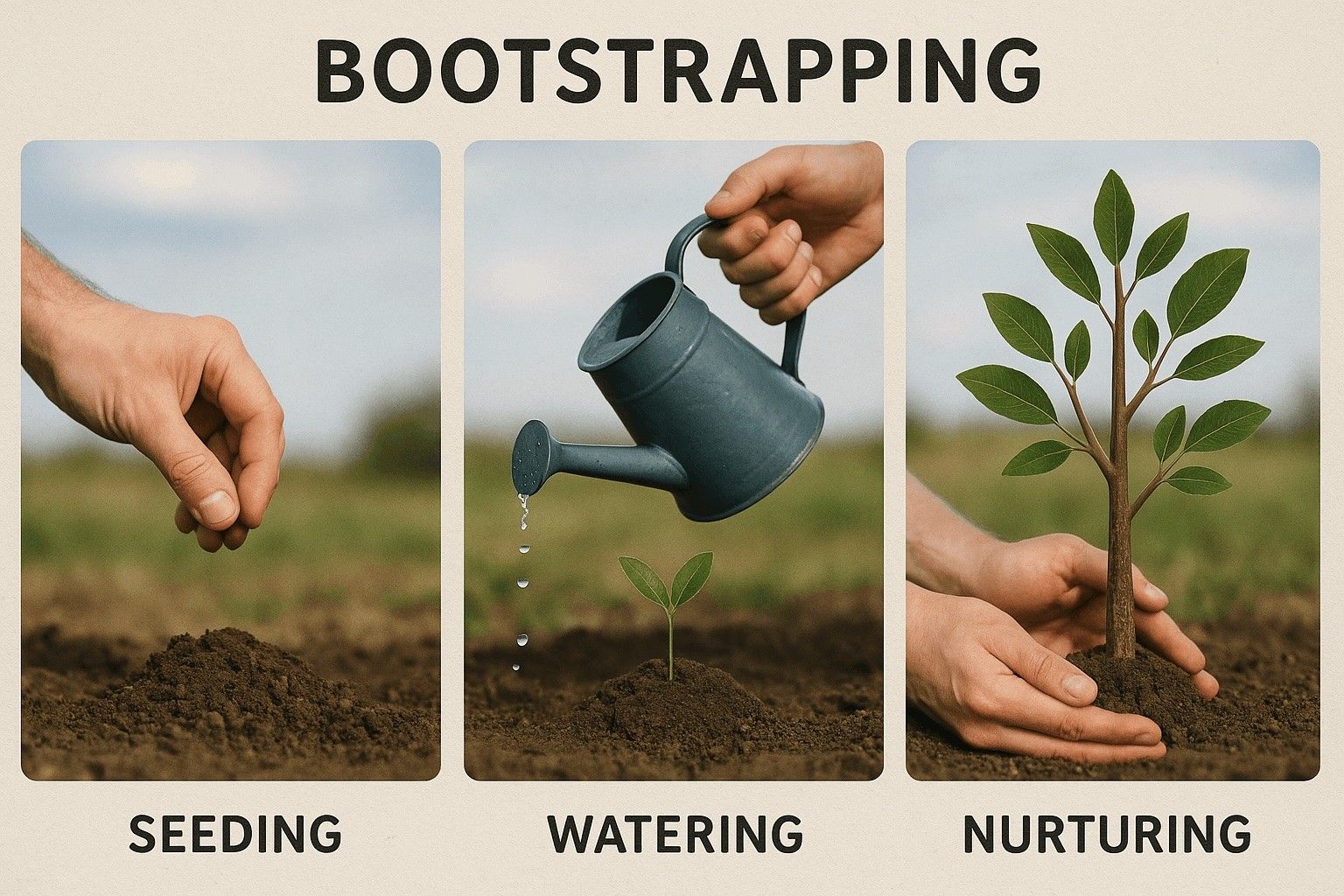Contents
the email tool that makes email marketing simple
Bootstrapping is like pulling yourself up by your own bootstraps. It symbolizes how to accomplish what seems impossible - launching and expanding a startup without external funding, just using personal savings and initial sales.
Bootstrapping is about self-sufficiency, creating a viable product with few resources. This method focuses on careful budgeting, creativity, and planning, aiming for gradual growth with low spending.
The article offers tips, success stories, and ways to tackle challenges like slow growth and scarce resources. It covers smart spending, affordable marketing, and efficient operations. It also talks about using technology to save money and improve online presence. The aim is to help entrepreneurs succeed in bootstrapping, providing advice for its specific challenges and chances.
So, what is bootstrapping, really?
Bootstrapping is like growing a tree from a seed by yourself, using only what you have. This approach depends on your personal savings and the money your startup makes, rather than external sources like loans or investors. It calls for creativity and careful planning, focusing on smart spending and consistent income. It’s not just about cutting costs, but also about fully using your skills, network, and unique ideas.
Bootstrapping is all about keeping full control over your company, letting it grow naturally according to your vision and hard work. This method creates a closer bond with your startup, as it's shaped by your personal commitment and effort. To understand more about the individuals who embark on this journey, read about what is a bootstrapper, which delves into the characteristics and stories of those who succeed in this challenging yet rewarding entrepreneurial path.
The History Behind the Term
As we said earlier, 'bootstrapping' initially meant attempting something basically impossible, like lifting oneself by one's bootstraps. It has since evolved to mean starting and succeeding on one's own efforts, without external help. The term became popular in the 20th century for entrepreneurs beginning with very little, using their savings and the first income from their startup. It represents the entrepreneurial spirit of resourcefulness and determination, overcoming challenges with creativity. Bootstrapping is now associated with building significant businesses through ongoing effort and innovation.
How to Bootstrap a Startup
Starting with a Strong Foundation
Bootstrapping starts with a strong idea, often combined with a more flexible approach rather than a fixed one. This flexibility is important because it lets you make quick changes based on what customers want, more important than having a detailed strategy, especially if you're not looking for external funding.
Understanding what the market wants from your product and being able to change direction when needed is just as important as being passionate about your idea.
Effective Budget Management
Managing your budget well is vital in bootstrapping; it's about spending your wisely and deciding where to use your resources best. Bootstrapping focuses on using your personal savings, which allows you to grow at your own speed and maintain complete control over your decisions.
Embracing a Lean Approach
Taking a lean approach is crucial. This means being efficient with resources and adaptable, always working to improve your operations without extra costs. The main focus should be on increasing revenue, mainly through effective sales strategies that ensure a consistent cash flow. This might involve exploring new ways to approach the market and continuously looking for innovative methods to attract customers.
Investing in Growth and Relationships
Reinvesting your earnings back into your company at regular intervals is important for further growth. Building strong relationships through networking can open up new opportunities and provide valuable advice for expansion. It's also essential to stay informed about the latest market trends and continually improve your skills at intervals to stay competitive. Lastly, focusing on customer satisfaction is key because happy customers often lead to more business and referrals, which is important for ongoing growth.
Planning for Sustainable Scaling
Finally, scaling up should happen gradually. Growth should be sustainable, based on the real performance and earnings, to prevent stretching too far and risking failure. During this process, it's important to stay focused on your goals, be resourceful, and remain flexible. Being financially disciplined, having a strong network, valuing customer relationships, and running a lean and agile operation are all key to success. Investing in yourself and balancing work and personal life are crucial to avoid burnout and keep motivated on your bootstrapping path.
Bootstrapping is a marathon, not a sprint. It requires patience, resilience, and a positive mindset. With these tips in mind, you will be prepared to guide your business towards success.
Advantages of Bootstrapping
Bootstrapping is about being independent. It goes beyond simply managing; it's about bringing your own ideas and values to life. This freedom gives you the power to make big decisions - to shape your buisiness to reflect your believes. Another advantage is also that you are fully in charge of your budget as well as strategic decisions. This makes it much easier to adapt quickly to a changing market.
Bootstrapping offers a profound experience, providing insights into many aspects of a small business. It strengthens resilience, as you start with a few resources, which boosts creativity and toughness. The joy of building a successful business from the ground up with your own hard work and ideas is huge.
Disadvantages of Bootstrapping
However, bootstrapping comes with challenges like limited and slow growth. Managing a tight budget is crucial, often requiring prioritization of essential expenses and creative problem-solving to maximize impact. This constraint is a constant test of fiscal discipline.
Slow growth is another challenge. Bootstrapped businesses typically expand more gradually than those with more funding, necessitating patience and resilience. Watching competitors grow rapidly can be difficult, and staying agile in a changing market with limited resources is demanding. Yet, overcoming these challenges often leads to a more resilient and adaptable business.
Real-Life Success Stories: Triumphs in Bootstrapping
Entrepreneurship is rich with inspiring bootstrapping success stories, offering valuable lessons for aspiring entrepreneurs.
Spanx, founded by Sara Blakely with $5,000, grew from an innovative idea for footless pantyhose into a multimillion-dollar company, demonstrating perseverance and meticulous management.
GitHub, created by Chris Wanstrath, PJ Hyett, and Tom Preston-Werner, evolved from a solution for developers' needs to a vital tool, leading to a $7.5 billion acquisition by Microsoft.
Basecamp, developed by Jason Fried and David Heinemeier Hansson, transitioned from a web design firm to a successful project management tool, emphasizing simplicity and effectiveness.
These stories showcase the potential of bootstrapping, where limited resources are offset by ingenuity and dedication. Key lessons include understanding customer needs, being resourceful and creative under constraints, prioritizing sustainable growth, engaging with the community, maintaining agility and adaptability, and staying true to the original vision. These strategies highlight that with the right approach, vision, and resilience, bootstrapping can lead to significant achievements.
Common Bootstrapping Techniques
In the realm of bootstrapping, using personal savings smartly is a cornerstone technique. It's about balancing financial risk, budgeting, and strategic expenditure. Entrepreneurs must first understand the risks involved and set clear boundaries on how much of their personal funds to invest, ensuring a balance between their financial health and their needs. Strategic budgeting is the next crucial step, requiring a realistic outline of expected costs and potential revenues, with a buffer for unforeseen expenses. This budget should prioritize spending on essentials that drive growth, such as development and key marketing initiatives.
In addition, long-term strategizing is essential. Entrepreneurs should not only address immediate needs but also consider future requirements, with a goal of achieving self-sustainability and profitability. This involves understanding the process of revenue generation and how reinvestments will fuel growth. Simultaneously, maintaining personal health is crucial. Entrepreneurs need to balance their personal commitments alongside their investments, ensuring that setbacks don't lead to personal hardship. Regular review and adjustment of their approach are also vital, allowing entrepreneurs to adapt to changing circumstances while keeping a close eye on their personal finances.
Low-cost marketing is another key aspect of bootstrapping. With limited budgets, entrepreneurs must be creative and efficient in promoting their operations. Social media is a cost-effective way to reach a wide audience, where engaging content can build a robust online presence. Regular updates, interactive posts, and visually appealing content can help attract and retain a targeted audience. Content marketing, including a series of blog posts, how-to guides, and videos, not only engages the audience but also boosts search engine rankings, increasing online visibility. Email marketing, using tools like Maildroppa, is an effective way to reach customers directly, providing valuable content and exclusive offers.
Community engagement and networking are also crucial for low-cost marketing. Building a network through community engagement and industry events can lead to valuable partnerships and collaborations. Customer reviews and testimonials are powerful tools, enhancing credibility and attracting new customers through word-of-mouth. Participating in local events or offering workshops related to your can also be effective in engaging with the community, raising its profile, and building a loyal customer base.
When it comes to operations, efficiency and cost-saving are vital. Leveraging technology is a key strategy, where software can automate tasks and facilitate team collaboration. Project management tools like Trello or Asana help keep teams on track, and accounting software simplifies. Negotiating with suppliers and vendors is essential for lowering operating costs, which could involve securing discounts or favorable payment terms. Embracing remote work can reduce overhead costs, increasing productivity and allowing access to a wider talent pool. Outsourcing non-core activities to freelancers on Upwork or specialized agencies enables solo founders to concentrate on core competencies and growth strategies.
Overall, these techniques underscore the importance of meticulous management, resourcefulness in, and efficiency in bootstrapping. They highlight the need for strategic, creative problem-solving, and a dynamic approach to growth, crucial for navigating the challenges and maximizing the opportunities of bootstrapping.
Seeking Assistance: When and How
For bootstrapped solo founders or indie hackers, seeking external assistance, particularly through networking and finding mentors, is crucial. Networking, the art of building professional relationships, is especially important for those with limited budgets. These connections can lead to potential clients, partners, and even investors. Expanding your network can be achieved by attending industry events, participating in online forums, and joining professional groups.
In today's digital landscape, social media platforms like LinkedIn, Twitter, and Facebook are powerful tools for networking. They allow you to connect with industry leaders, fellow bootstrappers, and potential customers globally. By engaging in relevant conversations and sharing valuable content, you can establish your presence and credibility in these communities.
Mentors are invaluable for entrepreneurs who are bootstrapping, offering guidance and sharing their experiences. They can help navigate the complexities of entrepreneurship, providing advice on strategic decision-making, managing resources, and tackling operational challenges. Finding a mentor who aligns with your values and goals is essential. This can be achieved through networking events, professional associations, or platforms like LinkedIn. When approaching potential mentors, it's important to be respectful and have a clear understanding of what you're seeking from the mentorship.
A mentor-mentee relationship should be mutually beneficial. While mentors provide guidance and support, mentees can offer new perspectives and ideas. Maintaining this relationship requires regular, honest communication, and setting clear expectations and goals for the mentorship ensures productivity and alignment.
Overall, networking and mentorship are key strategies for bootstrapped entrepreneurs. They provide access to a wealth of knowledge, experience, and opportunities that can significantly impact the success of an operation with limited resources. Through these relationships, entrepreneurs can gain insights, advice, and support, which are critical for navigating the challenges and maximizing the opportunities in their entrepreneurial journey.
The Risk-Reward Equation of Bootstrapping
Overall, networking and mentorship are key strategies for bootstrapped entrepreneurs. They provide access to a wealth of knowledge, experience, and opportunities that can significantly impact the success of an endeavor with limited resources. Through these relationships, entrepreneurs can gain insights, advice, and support, which are critical for navigating the challenges and maximizing the opportunities in their entrepreneurial journey.
In bootstrapping, the personal stakes are higher. Entrepreneurs often use their own savings and might not have a regular income, putting more of their own resources on the line for their business's success. They also face business challenges due to limited resources, which can make it harder to match the efficiencies of better-funded competitors in areas like production and distribution.
Despite these challenges, bootstrapping offers significant rewards. Entrepreneurs enjoy full control and ownership, allowing them to make decisions that align with their personal vision and business model. This approach also minimizes debt and equity dilution, fostering long-term independence. Furthermore, the hands-on nature of bootstrapping cultivates a wide range of skills, from managing resources to marketing, building a stronger foundation for the endeavor.
The satisfaction derived from bootstrapping is unique. There’s a profound sense of accomplishment in growing an endeavor from the ground up using limited resources. If it succeeds, the rewards are substantial given the full ownership retained by the by the entrepreneur.
Deciding if bootstrapping is right for you involves considering your personal goals and whether you want to maintain full control while growing slowly. You also need to think about your comfort with uncertainty, especially regarding your financial stability and willingness to use your own savings.
The kind of business also matters when considering bootstrapping. Some industries need a lot of money upfront, which makes bootstrapping hard. But businesses that offer services or operate digitally might find it easier. It's important to understand the market; in highly competitive markets where being fast is crucial, bootstrapping might not be the best choice. However, in niche markets or industries where steady growth is common, it could work well.
The entrepreneur's abilities and adaptability are crucial. Bootstrapping means taking on various roles and being open to new insights and quick adjustments. Having a strong network for guidance is helpful. Also, it's important to think about your long-term goals. If you want to keep full control and grow slowly, bootstrapping works well. But if you aim to expand rapidly or attract big investments, starting with bootstrapping may restrict those options.
Ultimately, personal happiness and fulfillment matter greatly. The experience of bootstrapping, with its ups and downs, should align with the entrepreneur's own idea of success. For those who find joy in creating something from nothing and conquering challenges, bootstrapping can be a fulfilling and satisfying journey.
Bootstrapping in Today's Digital Landscape
Bootstrapping involves using technology smartly to save money and establish a strong online presence. Key areas to concentrate on include using cloud computing for affordable infrastructure and adopting collaborative tools like Google Workspace or Microsoft 365 to reduce office and travel costs.
Automation is crucial for cutting operational expenses. Technologies like automated accounting and CRM systems not only reduce the need for staff but also improve operational efficiency, reducing mistakes and enabling a greater focus on essential business activities. The emergence of freelance platforms like Upwork and Fiverr has transformed outsourcing, providing cost-effective and flexible labor options.
In marketing, having a strong online presence is crucial. You can achieve this affordably by using platforms like WordPress or Wix to create a website, which serves as a digital storefront and plays a vital role in building trust and drawing in customers. Social media platforms like Facebook, Instagram, and LinkedIn provide cost-effective ways to reach a broad audience. Creating engaging content and using targeted social media advertising can deliver significant returns on your marketing investment.
Search Engine Optimization (SEO) is another important aspect of improving online visibility. By optimizing content for search engines, you can boost your company's search results ranking and attract organic traffic. Consistent blogging and creating content that's friendly to search engines are cost-effective ways to build authority and draw in a specific audience.
Content marketing, which includes blogs, videos, and infographics, is a powerful method for connecting with customers. It not only increases brand recognition but also establishes the business as an industry authority.
For bootstrapped endeavors, it's crucial to strike a balance between immediate operational requirements and a long-term vision. Planning for growth includes establishing realistic goals, regularly assessing strategies, and remaining flexible in response to market shifts. This planning should recognize potential drivers of growth and challenges, customizing strategies to maximize marketing results or invest in automation and outsourcing.
Building a strong culture that aligns with growth is vital. As operations scale, preserving core values and vision ensures consistency and fosters a positive work environment.
Transitioning from a self-funded approach to seeking external funding is a significant milestone. Operations should be investment-ready, with clear records. This preparation includes understanding different funding options - venture capital, angel investment, bank loans, or crowdfunding - each with unique implications for control and decision-making.
Preparing for investor pitches is crucial. A successful pitch goes beyond presenting the business plan; it involves articulating the business vision, demonstrating growth potential, and detailing how the investment will be utilized for scaling. A compelling narrative about the business journey, including challenges and achievements, is instrumental in attracting investors.
Bootstrappers vs Indie Hackers
While the journey of a bootstrapper is marked by self-reliance and the strategic use of personal funds and revenue for growth, indie hackers often traverse a parallel path with a distinct emphasis. Indie hackers, much like bootstrappers, build their businesses from the ground up, but they frequently leverage the power of community and digital platforms to propel their ventures.
Indie hackers are synonymous with the digital age, often focusing on creating software, apps, or platforms that solve specific problems or meet unique needs. Their approach is characterized by rapid iteration, direct engagement with their user base, and a lean methodology that prioritizes product-market fit from an early stage.
For those intrigued by the indie hacker ethos and seeking to explore how this community navigates the challenges and opportunities of entrepreneurship, the Indie Hackers Guide provides a comprehensive look into the strategies, tools, and stories of success within this vibrant ecosystem.
My Bootstrapping Journey: From Java Developer to Maildroppa Founder
Let me share with you my journey as a bootstrapper, not as a flawless success story, but as a personal, real-life adventure with its ups and downs, insights, and wins. It's a story of taking the path less traveled, making strategic moves, and most importantly, finding my way.
The Wake-Up Call
It all started at the end of 2014. I was 35, working as a Java developer, and I felt a growing need for more in my life. This wasn't about seeking dramatic changes or chasing overnight success; it was a deeper quest for fulfillment as I approached my 40s. Driven by curiosity and a desire for something new, I turned towards the path of entrepreneurship.
In 2015, I came across Rob Walling's "Start Small Stay Small," a book that became a pivotal resource for me. Its practical, actionable insights laid a solid foundation for anyone starting out in bootstrapping. While some strategies from the book may feel a bit dated in today's context, its core principles of starting and growing steadily remain relevant.
During this period, while maintaining my day job, I began developing a Java course and writing a book. This side activity was filled with its own set of challenges, including moments of doubt when things didn't go as expected. The support and advice I received from the Micropreneur Academy, a community of fellow entrepreneurs, were invaluable. This phase was not just about professional growth but also about personal learning and adaptation.
I moved to self-employment as a Java freelancer in mid-2019. This change wasn't abrupt but a well-thought-out move, based on what I learned and the confidence I built up before. During this period, I improved my Java skills and saved money for my next big project.
March 2020 marked a significant milestone with the launch of my email marketing SaaS, Maildroppa. This was not just the start of a new operation; it was the fruition of a journey filled with diverse experiences. Each success, each setback from my past projects, played a role in shaping Maildroppa. It was a product of perseverance, adaptability, and the lessons learned along a path filled with both highs and lows. Maildroppa stands as a testament to the journey, showcasing what can be achieved when you harness your experiences, both good and bad, to fuel your vision and drive forward.
Conclusion
To wrap up this guide, let's take a moment to reflect. Bootstrapping means starting and growing your operation using your own money and the profits you earn. It's all about being independent, creative, and resilient.
We've explored bootstrapping's main ideas, its history, and its role in today's world. We've discussed how to bootstrap effectively, balancing freedom and control with the challenges of limited funds and slow growth. Success stories, like Maildroppa's, show how diverse and rewarding this approach can be.
Key bootstrapping strategies include smart use of personal savings, low-cost marketing, and efficient operations. We also highlighted the importance of networking, getting advice, and considering alternative funding like crowdfunding. In today's digital age, using technology wisely and building an online presence are crucial.
We've also looked at the long-term, discussing how to grow a bootstrapped operation and possibly move towards external funding. By sharing my experience with Maildroppa, I hope to have inspired you to think about your own journey.
As you move forward with your bootstrapping journey, remember it's a journey filled with obstacles and chances for advancement. Every step is a move towards your goal. Stay focused on your vision and trust in yourself to make your dreams a reality.
Keep exploring, keep evolving, and most importantly, keep bootstrapping!
Additional Resources
Further Reading and Tools
Rob Walling: "Start Small, Stay Small"
A Developer’s Guide to Launching a Startup with No Outside Funding
The Original Podcast for Bootstrapped SaaS Entrepreneurs
Hosted by Rob Walling
The Micropreneur Academy
Founded by Mike Taber
Indie Hackers
An online community where independent entrepreneurs share their experiences and advice.
Product Hunt
A great place to discover new products, connect with other entrepreneurs, and get feedback on your own projects.
Contacts and Networks for Bootstrappers
Local Entrepreneur Meetups: Search for local meetups in your area to network with fellow entrepreneurs and share experiences.
LinkedIn Groups: Join LinkedIn groups related to bootstrapping and entrepreneurship for networking and resource sharing.
Twitter: Follow thought leaders, entrepreneurs, and fellow bootstrappers for insights and daily motivation.
















